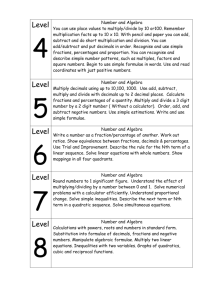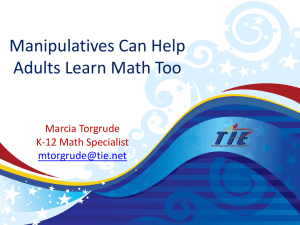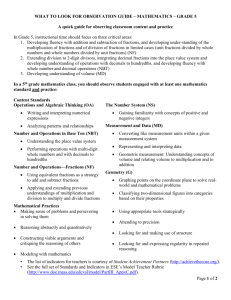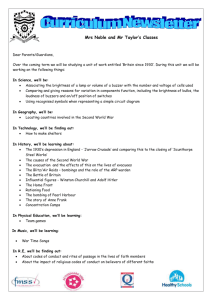Year 7 unit overview * Australian Curriculum: Mathematics
advertisement
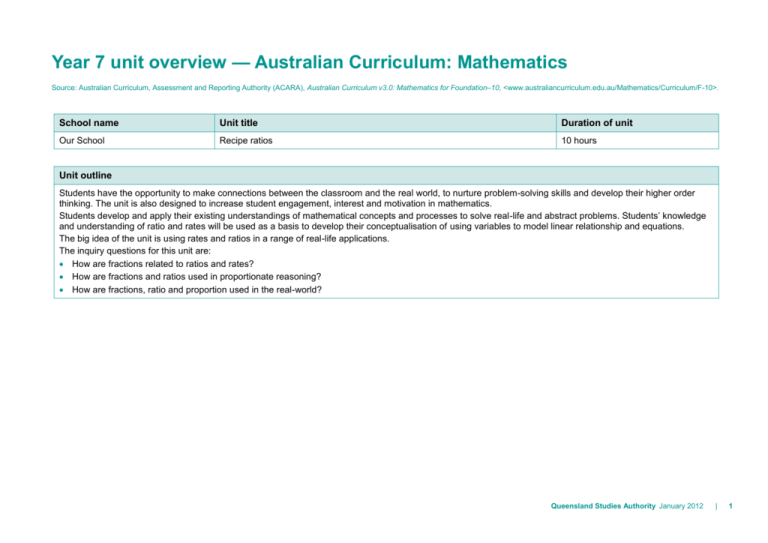
Year 7 unit overview — Australian Curriculum: Mathematics Source: Australian Curriculum, Assessment and Reporting Authority (ACARA), Australian Curriculum v3.0: Mathematics for Foundation–10, <www.australiancurriculum.edu.au/Mathematics/Curriculum/F-10>. School name Unit title Duration of unit Our School Recipe ratios 10 hours Unit outline Students have the opportunity to make connections between the classroom and the real world, to nurture problem-solving skills and develop their higher order thinking. The unit is also designed to increase student engagement, interest and motivation in mathematics. Students develop and apply their existing understandings of mathematical concepts and processes to solve real-life and abstract problems. Students’ knowledge and understanding of ratio and rates will be used as a basis to develop their conceptualisation of using variables to model linear relationship and equations. The big idea of the unit is using rates and ratios in a range of real-life applications. The inquiry questions for this unit are: How are fractions related to ratios and rates? How are fractions and ratios used in proportionate reasoning? How are fractions, ratio and proportion used in the real-world? Queensland Studies Authority January 2012 | 1 Identify curriculum Content descriptions to be taught Number and Algebra Measurement and Geometry Real numbers Compare fractions using equivalence. Locate and represent positive and negative fractions and mixed numbers on a number line (ACMNA152) Multiply and divide fractions and decimals using efficient written strategies and digital technologies (ACMNA154) Express one quantity as a fraction of another, with and without the use of digital technologies (ACMNA155) Connect fractions, decimals and percentages and carry out simple conversions (ACMNA157) Find percentages of quantities and express one quantity as a percentage of another, with and without digital technologies (ACMNA158) Recognise and solve problems involving simple ratios (ACMNA173) Patterns and algebra Create algebraic expressions and evaluate them by substituting a given value for each variable (ACMNA176) 2 | Year 7 unit overview Australian Curriculum: Mathematics Statistics and Probability General capabilities and cross-curriculum priorities Literacy Develop an understanding of the mathematical meanings of the key vocabulary associated with ratio, rates and proportionate reasoning Numeracy Apply mathematical understanding of ratio, rates and proportionate reasoning in a real-world context ICT capability Use web-based interactive programs and websites to engage and promote understanding of key concepts Critical and creative thinking Use higher order thinking skills to solve relevant problems in context and approach problems in different ways and in different contexts Personal and social capability Work in various groupings, including individual, pair, small group and whole class Achievement standard By the end of Year 7, students solve problems involving the comparison, addition and subtraction of integers. They make the connections between whole numbers and index notation and the relationship between perfect squares and square roots. They solve problems involving percentages and all four operations with fractions and decimals. They compare the cost of items to make financial decisions. Students represent numbers using variables. They connect the laws and properties for numbers to algebra. They interpret simple linear representations and model authentic information. Students describe different views of threedimensional objects. They represent transformations in the Cartesian plane. They solve simple numerical problems involving angles formed by a transversal crossing two parallel lines. Students identify issues involving the collection of continuous data. They describe the relationship between the median and mean in data displays. Students use fractions, decimals and percentages, and their equivalences. They express one quantity as a fraction or percentage of another. Students solve simple linear equations and evaluate algebraic expressions after numerical substitution. They assign ordered pairs to given points on the Cartesian plane. Students use formulas for the area and perimeter of rectangles and calculate volumes of rectangular prisms. Students classify triangles and quadrilaterals. They name the types of angles formed by a transversal crossing parallel line. Students determine the sample space for simple experiments with equally likely outcomes and assign probabilities to those outcomes. They calculate mean, mode, median and range for data sets. They construct stem-and-leaf plots and dot-plots. Proficiencies Opportunities to develop proficiencies include: Understanding recognising equivalences between fractions, decimals, percentages and ratios Fluency calculating accurately with integers representing fractions and decimals in various ways Problem Solving formulating and solving authentic problems using numbers and measurements Reasoning applying an understanding of ratio Queensland Studies Authority January 2012 | 3 Relevant prior curriculum Curriculum working towards In the Australian Curriculum: Mathematics at Year 6 Number and Algebra Number and place value Identify and describe properties of prime, composite, square and triangular numbers. Fractions and decimals Find a simple fraction of a quantity where the result is a whole number, with and without digital technologies. Make connections between equivalent fractions, decimals and percentages. Patterns and algebra Continue and create sequences involving whole numbers, fractions and decimals. Describe the rule used to create the sequence. In the Australian Curriculum: Mathematics at Year 8 Number and Algebra Real numbers Solve problems involving the use of percentages, including percentage increases and decreases, with and without digital technologies. Solve a range of problems involving rates and ratios, with and without digital technologies. Patterns and algebra Extend and apply the distributive law to the expansion of algebraic expressions. Factorise algebraic expressions by identifying numerical factors. Simplify algebraic expressions involving the four operations. Bridging content In the Essential Learnings by the end of Year 7 Knowledge and understanding: Number Numbers, key percentages, common and decimal fractions and a range of strategies are used to generate and solve problems. Percentages, rate, ratio and proportion can be used to describe relationships between quantities and to solve problems in practical situations involving money, time and other measures. Links to other learning areas Learning can be linked to experimental work in Science. Australian Curriculum: Science — Science as a Human Endeavour and Science Inquiry Skills 4 | Year 7 unit overview Australian Curriculum: Mathematics Assessment Make judgments Describe the assessment Assessment date Students are given opportunities to demonstrate their knowledge, skills and understanding through both formative and summative assessment. The assessment is collated in student folios and allows for ongoing feedback to students on their learning. Year 7 teachers make decisions about the length of time required to complete the tasks and the conditions under which the assessment is to be conducted. The teaching and learning experiences throughout the term provide opportunities for students to develop the understanding and skills required to complete these assessments. As students engage with these learning experiences the teacher can provide feedback on specific skills. Weeks 9 and 10 Use diagnostic assessment to identify students’ prior understandings about fractions, rates and ratios (e.g. Fractions Diagnostic Test from the QSA Assessment Bank). Mathematical investigation: Report (Written) Students document the mathematics involved in adapting a recipe. They select a recipe, and use the concept of ratio to adapt it for a larger or smaller quantity. The report includes relative percentages of ingredients (e.g. food labelling) and algebraic expressions that explain the mathematics they applied to the task (200–400 words). The assessment package Delicious drinks in the QSA Assessment Bank could be used in this unit. Teachers gather evidence to make judgements about the following characteristics of student work: Understanding selection and application of mathematical concepts and information to solve problems description of choices made, strategies used and conclusions reached, and checks of the reasonableness of solutions Skills application of problem solving strategies to investigate situations description of the results of mathematical investigations use of mathematical procedures and calculations to find solutions communication of explanations, solutions and calculations, using mathematical language, conventions and symbols For further advice and guidelines on constructing guides to making judgments refer to the Learning area standard descriptors: www.qsa.qld.edu.au Queensland Studies Authority January 2012 | 5 6 | Teaching and learning Supportive learning environment Teaching strategies and learning experiences Adjustments for needs of learners Resources Brainstorm in two groups: Group 1 documents their understanding of fractions; Group 2 documents their understanding of ratio. Students regroup to create a Venn diagram showing where the two concepts overlap. Create a word wall of the language associated with rates, ratios and proportion. Use interactive demonstrations to visually demonstrate different ratios and make linkages with fractions. Investigate ratio within recipes and how ratios can be scaled for different quantities, e.g. playdough, apricot balls. Design a survey (e.g. the nature of traffic driving past their school, food preferences, boys/girls in the class) and identify and record ratios in their data. Explore the concept of equivalence using hands-on resources. Use supermarket catalogues to investigate how ratios are used to find a specific amount, in particular when the conversion involves decimal or fractional factors. Investigate how ratios can be used to alter a specific amount. Focus on specific language associated with ratio and rates. Discuss how to divide an amount into a given ratio. Explore the connection to fractions and dividing amounts by the addition of all parts. Use interactive programs and sites from the internet to show the connection between ratio and rates. Explain the connection between ratios, rates and everyday life, e.g. finances. Section 6 of the Disability Standards for Education (The Standards for Curriculum Development, Accreditation and Delivery) states that education providers, including class teachers, must take reasonable steps to ensure a course/program is designed to allow any student to participate and experience success in learning. The Disability Standards for Education 2005 (Cwlth) is available from: <www.ag.gov.au> select Human rights and anti-discrimination > Disability standards for education. Equipment computers with internet access teacher computer with access to the internet and a data projector supermarket catalogues recipes Year 7 unit overview Australian Curriculum: Mathematics Use feedback Ways to monitor learning and assessment Teachers meet to collaboratively plan the teaching, learning and assessment to meet the needs of all learners in each unit. Teachers create opportunities for discussion about levels of achievement to develop shared understandings; co-mark or cross mark at key points to ensure consistency of judgments; and participate in moderating samples of student work at school or cluster level to reach consensus and consistency. Feedback to students Teachers strategically plan opportunities and ways to provide ongoing feedback (both written and informal) and encouragement to students on their strengths and areas for improvement. Students reflect on and discuss with their teachers or peers what they can do well and what they need to improve. Teachers reflect on and review learning opportunities to incorporate specific learning experiences and provide multiple opportunities for students to experience, practise and improve. Reflection on the unit plan Identify what worked well during and at the end of the unit, including: activities that worked well and why activities that could be improved and how assessment that worked well and why assessment that could be improved and how common student misconceptions that need, or needed, to be clarified. Queensland Studies Authority January 2012 | 7



